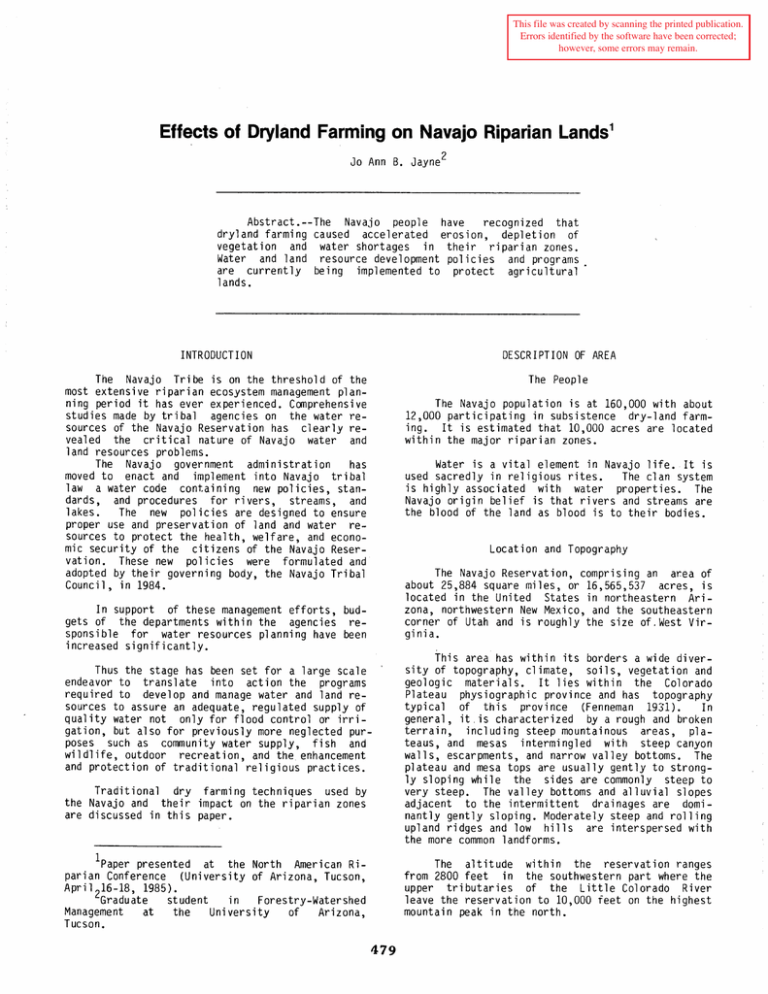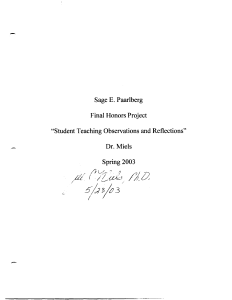Effects of Dryland Farming on ...
advertisement

This file was created by scanning the printed publication. Errors identified by the software have been corrected; however, some errors may remain. Effects of Dryland Farming on Navajo Riparian Lands 1 Jo Ann B. Jayne 2 Abstract.--The Navajo people have recognized that dryland farming caused accelerated erosion, depletion of vegetation and water shortages in their riparian zones. Water and land resource development policies and programs are currently being implemented to protect agricultural · lands. INTRODUCTION DESCRIPTION OF AREA The Navajo Tribe is on the threshold of the most extensive riparian ecosystem management planning period it has ever experienced. Comprehensive studies made by tribal agencies on the water resources of the Navajo Reservation has clearly revealed the critical nature of Navajo water and land resources problems. The Navajo government administration has moved to enact and implement into Navajo tribal law a water code containing new policies, standards, and procedures for rivers, streams, and lakes. The new policies are designed to ensure proper use and preservation of land and water resources to protect the health, welfare, and economic security of the citizens of the Navajo Reservation. These new policies were formulated and adopted by their governing body, the Navajo Tribal Council, in 1984. The People The Navajo population is at 160,000 with about 12,000 participating in subsistence dry-land farming. It is estimated that 10,000 acres are located within the major riparian zones. Water is a vital element in Navajo life. It is used sacredly in religious rites. The clan system is highly associated with water properties. The Navajo origin belief is that rivers and streams are the blood of the land as blood is to their bodies. Location and Topography The Navajo Reservation, comprising an area of about 25,884 square miles, or 16,565,537 acres, is located in the United States in northeastern Arizona, northwestern New Mexico, and the southeastern corner of Utah and is roughly the size of.West Virginia. In support of these management efforts, budgets of the departments within the agenc1es responsible for water resources planning have been increased significantly. Thus the stage has been set for a large scale endeavor to translate into action the programs required to develop and manage water and land resources to assure an adequate, regulated supply of quality water not only for flood control or irrigation, but also for previously more neglected purposes such as community water supply, fish and wildlife, outdoor recreation, and the. enhancement and protection of traditional religious practices. Traditional dry farming techniques used by the Navajo and their impact on the riparian zones are discussed in this paper. 1 Paper presented at the North American Riparian Conference (University of Arizona, Tucson, April 216-18, 1985). Graduate student in Forestry-Watershed Management at the University of Arizona, Tucson. This area has within its borders a wide diversity of topography, climate, soils, vegetation and geologic materials. It lies within the Colorado Plateau physiographic province and has topography typical of this province (Fenneman 1931). In general, it.is characterized by a rough and broken terrain, including steep mountainous areas, plateaus, and mesas intermingled with steep canyon walls, escarpments, and narrow valley bottoms. The plateau and mesa tops are usually gently to strongly sloping while the sides are commonly steep to very steep. The valley bottoms and alluvial slopes adjacent to the intermittent drainages are dominantly gently sloping. Moderately steep and rolling upland ridges and low hills are interspersed with the more common landforms. The altitude within the reservation ranges from 2800 feet in the southwestern part where the upper tributaries of the Little Colorado River leave the reservation to 10,000 feet on the highest mountain peak in the north. 479 texture, and light or reddish-brown in color. The soils will support a pinyon-oak association in the higher elevations interspersed with big sagebrush (Artemisia tridentata). Big sagebrush is often an understory of the p1nyon-juniper. Associated shrubs and grasses are Stansbury cliffrose (Cowania mexicana) and crested wheatgrass (Agropyron desertorum). Lower elevations are character1zed by scattered pinyon-juniper, extensive areas of big sagebrush, galleta, and Indian rice grass (Oryzopsis hymenoides). Much of the country, however, has an altitude that ranges between 6,000 feet and 7,800 feet. Altitudes above 7,800 feet are mainly in the Navajo commercial forest which lies predominantly in the center of the reservation and constitutes approximately four percent of the land. Climate The reservation generally has a semi-arid continental climate with mean annual precipitation ranging from six inches in the southwestern plains to twenty-five inches in the mountain ranges along the Arizona-New Mexico border (BIA 1981). Altitude These areas are dominated by soils over sandstone and are deep to shallow, ioomy, dark-colored, and with some rock outcrops. The highest elevations are characterized by Engelmann spruce (Picea engelmanni i), alpine fir (Abies las i ocarpaT:Wflite fir (Ables concolor) with outcrops of quaking aspen (Populus tremuloides). The intermediate and lower elevations supports stands of ponderosa pine (Pinus ponderosa var. scopulorum) with Colorado~ spruce (Picea pungens), wavyleaf oak (Quercus undulata), and p1nyon pine (Pinus edulis). Grasses 1nclude mountain muhly (MUhlenoergla montana), Arizona fescue (Festuca arizon1ca), and galleta. More than forty percent of the annual precipitation falls in July through September, mostly from heavy thunderstorms. During the summer most moisture comes from the Gulf of Mexico, entering the reservation from the southeast in the general air circulation about the Bermuda high pressure area which is displaced westward (BIA 1981). The main source of moisture in winter is Pacific Ocean storms moving eastward in the zonal ci rcu l at ion. Average annual snowf a11 ranges from less than two feet in drier sections to more than six feet in the areas of greatest precipitation. The season of most snowfall is November through April. TRADITIONAL USES OF RIPARIAN ZONES The Navajo economy in the early 19oo•s was a simple arrangement of subsistence exploitation of the geographical landscape, and exchange of goods either for other goods or for money and credit. Ali of the exploitative and many exchange activities were directly connected with the use of the land. Mean annual temperatures range mostly from 48 to 52 degrees Fahrenheit. Extremes of temperature have been over 100° F. and -20° to -30° F. in the winter (BIA 1981). May through October are the warmest month of the year. Subsistence Dryland Farming Soils and Vegetation Altitude Farming Practices.--Corn, hay, beans, potatoes, peaches, wheat, vegetables, and melons constituted the principal non-commercial, agricultural products in 1940. Corn brought in 39 percent of the $450,100 income generated for that year (BIA 1941). - 4,500 feet to 6,000 feet The soils and climate in these areas contribute to a grassland and mixed shrubland plant comunity. At upper elevational ranges are pinyonjuniper woodlands characterized by Rocky Mountain juniper (Juniperus scopulorum), Utah juniper (Juniperus osteosperma), rabb1tbrush (Chrysotham~ nauseosus), greasewood (Sarcobatus and snakeweed (Gut1errez1a vermiculatus), microcephala). The grass dominated lands occur on the deeper soils on relatively level to gently rolling terrain. They are characterized by red (Aristida longiseta), blue grama three-awn (Bouteloua crac1l1s), and galleta (Hilaria james11). Generally the soils are derived form alluv1al deposits and aeobian sources and are commonly deep, light in texture, and reddish -brown. Rock outcrops and badlands are prominent features in some areas. Altitude - 7,800 feet to 10,000 feet Fields were small and often irregular and were often outlined by uncleared trees, gullies, or cliffs. Preparation of ground for planting began at the end of April and plowing and planting lasted through early June. Planting was done at the time of plowing, without any intervening ground preparation. It was often accompanied by various rites and ritual procedures. Straight furrows were plowed without regard to contour. Manure or other fertilizers were seldom used, nor were fields ever intentionally followed. Insects, early frosts, and torrential rainfalls sometimes killed or washed out whole fields of new seedlings and made replanting necessary. - 6,000 feet to 7,800 feet During the busy times of plowing, planting, cultivating, and harvesting, the cooperation among the various kin groups was intensive. Even so, crops were frequently planted late and yields were cut by early fall frosts. Total acres planted in These areas are dominated by soils over shale and sandstone and/or by soils in residuum and alluvium from sandstone and redbeds. They are commonly deep to moderately deep, light in 480 1941 was 32,201 acres with 29,840 year ( BIA 1941). The.history of water resource planning on the Navajo Reservation is dominated by periodic adaptation to the demands for use of water by its growing population and increasing economic activity. harvested that Field Location and Water Sources.--Field location was dependent upon water sources from 1) rainfall, 2) groundwater, or 3) floodwater from surf ace flooding of ephemera 1 streams. Fields dependent in these areas: There was early recognition of the multipleuse possibilities of water projects and of the interrelationship of the water and land resources within stream and river basins by the local people. In spite of the intensive thought and effort given to this subject and the encouraging developments in the past few years, the Navajo Tribe still lacks a fully coordinated policy and a definite, sound program for riparian ecosystem planning of its streams and rivers. upon rainfall were located A. On high alluvial plateaus with deep drainage lines. Soils are shallow, residual sandy loam derived from sandstone and shale. In contrast to past case by case project authorizations, the Navajo has now developed a water code. With its prospective on the pressing water needs of the next few decades, this code can augment desirability for action and reiterate the need for comprehensive water resources development. B. On thin aeolian soils over lava beds. Soils are shallow, clay loam derived from basalt. Fields primarily watered by surface runoff or by ground water moisture were located in these areas: A. On flood plains or flat stream terraces of larger valleys. B. The stage for progress has been set further by the accumulated weight of: 1) water policy regulation, 2) improvement of standards and techniques for formulation and evaluation, and 3) experiments in interagency planning. On bottoms of small, deep, sandy canyons. C. Near upper ends of canyons or valleys, or on colluvial and alluvial outwash slopes. However, water and land resources will always be threatened regardless of ownership and laws. Each segment of the Navajo population has an important stake in the proper development of water resources. EFFECTS OF DRYLAND FARMING An accelerated erosion cycle beginning shortly after the practice of dryland farming caused a shift of land holdings. Many farms once advantagely located for water became useless and were abandoned because of gullying and trenching. This was especially true in the regions where floodwater irrigation was practiced. Fields formerly supplied by floodwater had become dependent on rainfall. Farmers were gradually forced by terrain changes and landownership problems toward cultivation of fields farther away from the riparian zones. It has not yet been clearly defined either in general pol icy statements nor in actual experience how comprehensive water resources development plans should be implemented and sustained on the Navajo Reservation. However, water resource development programs on the Navajo Reservation should maximize their contrtbution to economic growth and represent efficient low cost means of obtaining the products or services they provide. LITERATURE CITED Navajo impact on riparian zones essentially began with the development of dryland farming. Trees and other vegetation were removed for agriculture and houses. Diversion of water from streams and rivers created water shortages. Erosion was accelerated as vegetative cover was removed. Fenneman, N.M. 1931. Physiography of the Western United States. McGraw-Hill Book Company, New York. U.S. The Navajo people have recognized that soil erosion from early dryland farming has caused, in part, the damages of down-stream areas. These areas lie idle today. Department of Interior, Bureau of Indian Affairs. 1941. Statistical summary, human dependency survey, Navajo Reservation. 1940. 108 p. u.s. CONCLUSION 481 Department of Interior, Bureau of Indian Affairs. Navajo Water Resources 1981. Evaluation. Volume II, Part I. p. 1-2.




